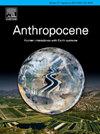Effect of nutrient enrichment and climate change on historical changes of the cyanobacterial community in a shallow north temperate lake in China
IF 3.3
2区 地球科学
Q2 ENVIRONMENTAL SCIENCES
引用次数: 0
Abstract
Quantitative ecological reconstructions in lakes can be potentially significant for providing long-term environmental records and the information generated would become invaluable source for comprehensive understanding of the effects of human disturbances and climate change on lake ecosystem. Our aim is to explore the drivers of historical changes of the cyanobacterial community in a shallow temperate freshwater system, Baiyangdian Lake Complex (BLC), in northern China. We used a multi-proxy approach (e.g., sedimentary DNA, subfossil diatom assemblages) to establish the historical changes of the cyanobacterial community in BLC over different stages as accurately as possible. At Stage 1 (∼1902–2012), the cyanobacterial co-occurrence network analysis revealed more complex interactions among different genera than at Stage 2 (∼2012–2021) in all three sampling sites. The reconstructed cyanobacterial community correlated well with changes of the sedimentary diatom species composition, geochemical indices and historically documented events in the watershed. The cyanobacterial abundance in two advanced hydrologically-connected sampling sites (Shaochedian, Caiputai) was mainly regulated by the dynamics of TP and TN, while the other relatively weak hydrologically-connected site (Zaozhadian) was regulated by precipitation. Therefore, a reduction in nutrient inputs is still the most prudent option to avoid risk of the outbreak of cyanobacterial blooms in BLC. Meanwhile, intact hydrological connectivity within the wetland complex is also essential to reduce pollution and cyanobacterial blooms through mixing and flushing. Although the fate of cyanobacterial blooms in BLC has been greatly reduced over the recent time, resource managers should not only adopt conventional approaches (e.g., nutrient control) but also incorporate a landscape scale limnological-based monitoring approaches to resolve the long-lasting cyanobacterial bloom problem induced by coupled human and climate change disturbances.
求助全文
约1分钟内获得全文
求助全文
来源期刊

Anthropocene
Earth and Planetary Sciences-Earth and Planetary Sciences (miscellaneous)
CiteScore
6.30
自引率
0.00%
发文量
27
审稿时长
102 days
期刊介绍:
Anthropocene is an interdisciplinary journal that publishes peer-reviewed works addressing the nature, scale, and extent of interactions that people have with Earth processes and systems. The scope of the journal includes the significance of human activities in altering Earth’s landscapes, oceans, the atmosphere, cryosphere, and ecosystems over a range of time and space scales - from global phenomena over geologic eras to single isolated events - including the linkages, couplings, and feedbacks among physical, chemical, and biological components of Earth systems. The journal also addresses how such alterations can have profound effects on, and implications for, human society. As the scale and pace of human interactions with Earth systems have intensified in recent decades, understanding human-induced alterations in the past and present is critical to our ability to anticipate, mitigate, and adapt to changes in the future. The journal aims to provide a venue to focus research findings, discussions, and debates toward advancing predictive understanding of human interactions with Earth systems - one of the grand challenges of our time.
 求助内容:
求助内容: 应助结果提醒方式:
应助结果提醒方式:


